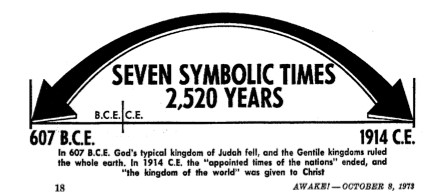In last week’s post, I showed how the Watchtower arrives at its 1914 date for the end of the Gentile Times.
As I noted, its calculations are dependent on its claim that Jerusalem fell to Nebuchadnezzar and the Babylonians in 607 B.C.E.
If that date is wrong, then the 1914 date is also wrong.

In fact, Jerusalem fell to Nebuchadnezzar in approximately 586 B.C.E., not in 607 B.C.E.
Jehovah’s Witnesses will trust the Watchtower over secular historians, so we will use a Watchtower book to convince them.
2 Kings 25:8-9 tells us that Jerusalem fell to Nebuchadnezzar in the 19th year of his reign, so we need to establish when the 19th year of his reign took place.
The 1988 Watchtower book, Insight on the Scriptures, Volume 2, discusses Babylonian chronology. This book is available on the Watchtower’s website.
While it gives dates for the Babylonian kings that support its 607 BCE date, the internals of the article don’t match. In fact, they support the 586 B.C.E. date.
Here’s how to show it to them.
Let’s work our way back from the date on which Babylon fell to the Medes and Persians.
Watchtower references are footnoted:
Nabonidus’ reign ended when Babylon fell: 539 B.C.E. [1]
Nabonidus reigned: + 17 years [2]
Nabonidus succeeded Labashi-marduk, who reigned: + ¾ year [3]
Labashi-marduk succeeded Neriglissar, who reigned: + 4 years [4]
Neriglissar succeeded Evil-merodach, who reigned: + 2 years [5]
Evil-merodach succeeded Nebuchadnezzar, who reigned: + 43 years [6]
Totaling the column, Nebuchadnezzar’s reign began in 605 B.C.E.
Based on this, Nebuchadnezzar’s 19th year was therefore 605 B.C.E.–19 years = 586 B.C.E.
This means Jerusalem fell to Babylon in 586 B.C.E., not 607 B.C.E., as claimed by the Watchtower.
You can sum it up this way: “By the internals of the Watchtower’s own Babylonian royal calendar, Jerusalem fell in 586 B.C.E., not 607 B.C.E. If so, the 1914 date is wrong.”
Please note that you don’t need to agree with the Watchtower’s calendar in order to use this approach. The fact is that it’s the Watchtower’s calendar and it disagrees with its own teaching.
Jehovah’s Witnesses will point out that the article you quoted gives the 607 B.C.E. date, and they will present you with all sorts of arguments in support of that date.
The fact remains that the internals of the Watchtower’s own Babylonian regnal chronology don’t match.
For this reason, you can keep coming back to your soundbite and referring them to the internals of the Watchtower’s own Babylonian regnal list and ask for their explanation.
This discrepancy should trouble sincere Witnesses long after your conversation has ended.
Endnotes:
[1] “Babylon fell in 539 B.C.” Babylon the Great Has Fallen – God’s Kingdom Rules, p.184
[2] “On the basis of cuneiform texts he is believed to have ruled some 17 years (556-539 B.C.E.).” Insight on the Scriptures, Vol. 2, p. 457
[3] “Labashi-Marduk … was a vicious boy, and within nine months he had his throat cut by an assassin.” Babylon the Great Has Fallen – God’s Kingdom Rules, p.184
[4] “Neriglissar … reigned four years.’ Babylon the Great Has Fallen – God’s Kingdom Rules, p.184
[5] “After reigning but two years King Evil-Merodach was murdered.” Babylon the Great Has Fallen – God’s Kingdom Rules, p.184 “Nebuchadnezzar ruled as king for 43 years” Insight on the Scriptures, Volume 2, p. 480
[6] “Nebuchadnezzar ruled as king for 43 years.” Insight on the Scriptures, Volume 2, p. 480

Leave a Reply
Be the First to Comment!